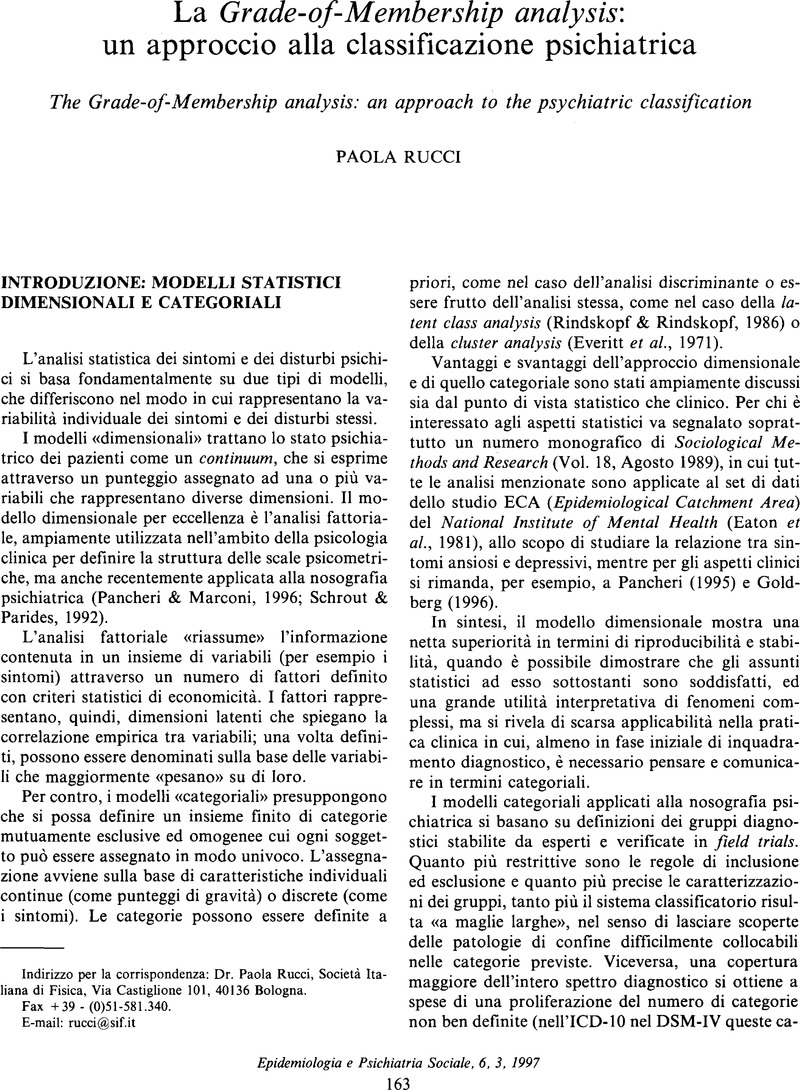No CrossRef data available.
Article contents
The Grade-of-Membership analysis: an approach to the psychiatric classification
Published online by Cambridge University Press: 11 October 2011
Abstract
An abstract is not available for this content so a preview has been provided. As you have access to this content, a full PDF is available via the ‘Save PDF’ action button.

- Type
- Editorials
- Information
- Copyright
- Copyright © Cambridge University Press 1997
References
BIBLIOGRAFIA
Blazer, D., Swartz, M., Woodbury, M., Manton, K.G., Hughes, D. & George, L.K. (1988). Depressive symptoms and depressive diagnoses in a community population. Archives of General Psychiatry 45, 1078–1084.CrossRefGoogle Scholar
Davidson, J., Woodbury, M.A., Pelton, S. & Krishnam, R. (1988). A study of depressive typologies using grade of membership analysis. Psychological Medicine 18, 179–189.CrossRefGoogle ScholarPubMed
Eaton, W.W., Regier, D.A., Locke, B.Z. & Taube, C.A. (1981). The epidemiological catchment area program of the National Institute of Mental Health. Public Health Reports 96, 319–325.Google ScholarPubMed
Everitt, B.S., Gourlay, A.J. & Kendell, R.E. (1971). An attempt at validation of traditional psychiatric syndromes by cluster analysis. British Journal of Psychiatry 119, 399–412.CrossRefGoogle ScholarPubMed
Goldberg, D. (1996). A dimensional model for common mental disorders. British Journal of Psychiatry 168, Suppl. 30, 44–49.CrossRefGoogle Scholar
Manton, K.G., Korten, A., Woodbury, M.A., Anker, M. & Jablensky, A. (1994). Symptom profiles of psychiatric disorders based on graded disease classes: an illustration using data from the WHO International Pilot Study of Schizophrenia. Psychological Medicine 24, 133–144.CrossRefGoogle ScholarPubMed
Pancheri, P. (1995). Approccio dimensionale e approccio categoriale alia diagnosi psichiatrica. Giornale Italiano di Psicopatologia 1–3, 8–23.Google Scholar
Pancheri, P. & Marconi, P.L. (1996). Le dimensioni della schizofrenia. Giornale Italiano di Psicopatologia 1, 10–41.Google Scholar
Piccinelli, M., Rucci, P., Ustiin, T.B. & Simon, G. (1997). Typologies of anxiety, depresison and somatization symptoms among primary care attenders with no formal psychiatric disorder. Findings from an International Study using grade of membership analysis. Archives of General Psychiatry (submitted for publication).Google Scholar
Rindskopf, R. & Rindskopf, W. (1986). The value of latent class in medical diagnosis, Statistics in Medicine 5, 21–27.CrossRefGoogle ScholarPubMed
Schrout, P. & Parides, M. (1992). Conventional factor analysis as an approximation to latent trait models for dichothomous data. International Journal of Methods in Psychiatric Research 2, 55–65.Google Scholar
Swartz, M., Blazer, D., Woodbury, M., George, L. & Landerman, R. (1986). Somatization disorder in a US Southern community: use of a new procedure for analysis of medical classification. Psychological Medicine 16, 595–609.CrossRefGoogle Scholar
Woodbury, M.A. & Manton, K.G. (1982). A new procedure for analysis of medical classification. Metheds of Information in Medicine 21, 210–220.Google ScholarPubMed
Woodbury, M. & Manton, K.G. (1989). Grade of membership analysis of depression-related psychiatric disorders. Sociological Methods and Research 18, 126–163.CrossRefGoogle Scholar
Woodbury, M., Clive, J. & Garson, A. (1978). Mathematical typology: a grade of membership technique for obtaining disease definition. Computers and Biomedical Research 11, 277–298.CrossRefGoogle ScholarPubMed




